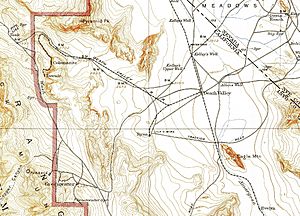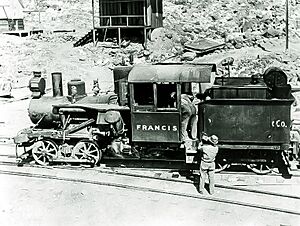Death Valley Railroad facts for kids
| Overview | |
|---|---|
| Headquarters | Ryan, California |
| Reporting mark | DVRR |
| Locale | Ryan, California and Death Valley Junction, California |
| Dates of operation | 1914–1931 |
| Technical | |
| Track gauge | 3 ft (914 mm) |
The Death Valley Railroad (DVRR) was a special kind of train line. It was a narrow gauge railroad, meaning its tracks were closer together than regular train tracks. This railway operated in California's famous Death Valley.
Its main job was to carry a mineral called borax. This borax came from mines near Ryan, California and Lila C. The train then took the borax about 20 miles (32 km) to Death Valley Junction. From there, the borax could be shipped to other places for processing.
Contents
History of the Death Valley Railroad
Building the Borax Railway
Around 1914, the mines at Lila C. were producing less borax. So, the Pacific Coast Borax Company started looking for new, richer borax deposits. They found some new mines a bit west of Furnace Creek.
Plans were made to build a new narrow gauge railroad. This new line would connect the fresh mines to the Tonopah and Tidewater Railroad. This larger railway was at Death Valley Junction. It would help ship the borax away.
The Death Valley Railroad was built by a separate company. The Pacific Coast Borax Company was having money problems at the time. They used old equipment and a special train engine called "Francis" (a Heisler locomotive) from their older railway, the Borate and Daggett Railroad.
After the tracks were finished, two new steam locomotives were bought. These were 2-8-0 engines from the Baldwin Locomotive Works. The old "Francis" engine was then sold.
Daily Life and End of the Line
A train ran once a day on the Death Valley Railroad. It brought food and water to the workers at the Ryan mine. In the late afternoon, it carried the borax ore back.
Later, even better borax deposits were found in Boron. This meant less borax was needed from Death Valley. The Death Valley Railroad tried to stay open by carrying tourists. They even bought a special Brill railcar for visitors. This car took tourists to see the old mines.
But there wasn't enough profit from tourists or freight. The mines also closed down. So, the Death Valley Railroad had to close in 1931.
Much of the old railway tracks ran next to what is now State Route 190.
What Happened Next?
After the Death Valley Railroad closed, another company bought its equipment. The United States Potash Company bought the tracks and trains. They used them to build their own railway. This new line was near Loving, New Mexico. It became known as the United States Potash Railroad.
All the rails from the Death Valley Railroad were used there. This lasted until about 1941. Then, heavier rails from the Atchison, Topeka and Santa Fe Railway replaced them. The United States Potash Railroad ran until 1967. By then, new potash deposits were found in Saskatchewan. Also, the Pacific Coast Borax Company merged with U.S. Potash. They became U.S. Borax & Chemical Cooperation.
Preserving the Old Trains
It's cool to know that all three main engines from the Death Valley Railroad are still around! After the United States Potash Railroad started using diesel engines in the 1950s, the two old Death Valley Railroad engines were saved.
Engine No. 1
Engine No. 1 was sent to Carlsbad, New Mexico. You can see it on display between Park Drive and E. Riverside Drive. It has "U.S. Potash" written in big letters on its side.
Engine No. 2
Engine No. 2 also worked for the United States Potash Railroad. But then, the Death Valley National Park bought it. Today, you can find it at the Borax Museum in Furnace Creek.
The Tourist Railcar
A special railcar was bought in 1928. The Pacific Coast Borax Company hoped it would save their railways. They wanted to make them tourist attractions. This railcar was also bought by the United States Potash Railroad. It carried workers to the potash mines.
By 1967, the railcar was very old and worn out. But the Laws Rail Museum in Bishop, California stepped in! They saved it from being scrapped. After many years of hard work to fix it up, the railcar now runs happily. You can see it on the museum's 3 ft (914 mm) narrow gauge track.
Other Surviving Parts
Some parts of the old DVRR ore cars are still at the Laws Rail Museum. The old caboose (train car #100) is also still around. It's on the property of the old potash refinery site in Loving, New Mexico. Even some old tank car bodies from the DVRR are located just outside Carlsbad.
The old Heisler locomotive named "Francis" was used to build the DVRR. It worked on the line for a few years after construction. But then, the new Baldwin engine No. 2 arrived in 1916. "Francis" was then sold to the Nevada Short Line Railway. It later worked for a timber company. Sadly, it was scrapped around 1925 after a big fire at the lumber mill.




